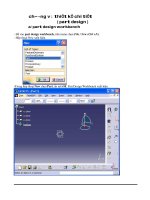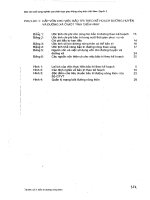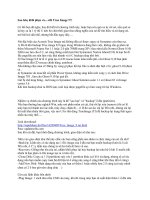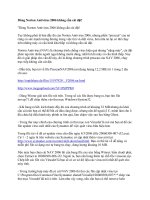CNNA3-Chapter 5: Part I potx
Bạn đang xem bản rút gọn của tài liệu. Xem và tải ngay bản đầy đủ của tài liệu tại đây (3.28 MB, 64 trang )
CCNA3-1
Chapter 5-1
Chapter 5
Chapter 5
Spanning Tree Protocol
Spanning Tree Protocol
(STP)
(STP)
Part I
Part I
CCNA3-2
Chapter 5-1
Spanning Tree Protocol (STP)
Spanning Tree Protocol (STP)
Redundant Layer 2 Topologies
Redundant Layer 2 Topologies
CCNA3-3
Chapter 5-1
Redundant Layer 2 Topologies
Redundant Layer 2 Topologies
•
As businesses become increasingly dependent on the
As businesses become increasingly dependent on the
network, the availability of the network infrastructure
network, the availability of the network infrastructure
becomes a critical business concern.
becomes a critical business concern.
•
Redundancy
Redundancy
is the solution for achieving the necessary
is the solution for achieving the necessary
availability.
availability.
•
Layer 2 redundancy improves the availability of the
Layer 2 redundancy improves the availability of the
network by implementing
network by implementing
alternate network paths
alternate network paths
by
by
adding equipment and cabling.
adding equipment and cabling.
•
Having multiple paths for data to traverse the network
Having multiple paths for data to traverse the network
allows for a single path to be disrupted
allows for a single path to be disrupted
without impacting
without impacting
the connectivity of devices on the network.
the connectivity of devices on the network.
CCNA3-4
Chapter 5-1
Redundancy
Redundancy
CCNA3-5
Chapter 5-1
Redundancy
Redundancy
Redundant paths create
Redundant paths create
loops
loops
in the network.
in the network.
Redundant paths create
Redundant paths create
loops
loops
in the network.
in the network.
How are they controlled?
How are they controlled?
Spanning Tree Protocol
Spanning Tree Protocol
How are they controlled?
How are they controlled?
Spanning Tree Protocol
Spanning Tree Protocol
CCNA3-6
Chapter 5-1
Redundancy
Redundancy
•
The Spanning Tree Protocol
The Spanning Tree Protocol
(STP)
(STP)
is enabled on all
is enabled on all
switches.
switches.
•
STP has placed some switch ports in
STP has placed some switch ports in
forwarding
forwarding
state and
state and
other switch ports in
other switch ports in
blocking
blocking
state.
state.
Forward
Forward
Forward
Forward
Blocked
Blocked
Blocked
Blocked
CCNA3-7
Chapter 5-1
Issues with Redundancy
Issues with Redundancy
•
Redundancy
Redundancy
is an important part of the hierarchical design.
is an important part of the hierarchical design.
•
When multiple paths exist between two devices on the
When multiple paths exist between two devices on the
network and
network and
STP has been disabled
STP has been disabled
on those switches, a
on those switches, a
Layer 2 loop
Layer 2 loop
can occur.
can occur.
•
If
If
STP is enabled
STP is enabled
on these switches,
on these switches,
which is the default
which is the default
,
,
a
a
Layer 2 loop would not occur
Layer 2 loop would not occur
.
.
CCNA3-8
Chapter 5-1
Issues with Redundancy
Issues with Redundancy
•
Ethernet frames do not have a
Ethernet frames do not have a
Time-To-Live (TTL)
Time-To-Live (TTL)
parameter
parameter
like IP packets.
like IP packets.
•
As a result, if they are not terminated properly on a
As a result, if they are not terminated properly on a
switched network, they continue to bounce from switch to
switched network, they continue to bounce from switch to
switch endlessly.
switch endlessly.
CCNA3-9
Chapter 5-1
Issues with Redundancy
Issues with Redundancy
•
Remember that switches use the
Remember that switches use the
Source MAC address
Source MAC address
to
to
learn where the devices are and
learn where the devices are and
enters this information
enters this information
into
into
their MAC address tables.
their MAC address tables.
•
Switches will
Switches will
flood the frames for unknown destinations
flood the frames for unknown destinations
until
until
they learn the MAC addresses of the devices.
they learn the MAC addresses of the devices.
CCNA3-10
Chapter 5-1
Issues with Redundancy
Issues with Redundancy
•
Additionally,
Additionally,
multicasts and broadcasts
multicasts and broadcasts
are also flooded out
are also flooded out
all ports except the receiving port.
all ports except the receiving port.
(Multicasts will not be
(Multicasts will not be
flooded if the switch has been specifically configured to
flooded if the switch has been specifically configured to
handle multicasts.)
handle multicasts.)
CCNA3-11
Chapter 5-1
Issues with Redundancy
Issues with Redundancy
PC1 sends a
PC1 sends a
broadcast.
broadcast.
PC1 sends a
PC1 sends a
broadcast.
broadcast.
S2 receives the
S2 receives the
frame and updates
frame and updates
the MAC table.
the MAC table.
S2 receives the
S2 receives the
frame and updates
frame and updates
the MAC table.
the MAC table.
S2 floods the
S2 floods the
broadcast out all
broadcast out all
ports except the
ports except the
receiving port.
receiving port.
S2 floods the
S2 floods the
broadcast out all
broadcast out all
ports except the
ports except the
receiving port.
receiving port.
S3 and S1 update
S3 and S1 update
their MAC tables
their MAC tables
S3 and S1 update
S3 and S1 update
their MAC tables
their MAC tables
S3 and S1 now
S3 and S1 now
flood the broadcast.
flood the broadcast.
S3 and S1 now
S3 and S1 now
flood the broadcast.
flood the broadcast.
S3 and S1 update
S3 and S1 update
their MAC tables
their MAC tables
with the wrong
with the wrong
information
information
S3 and S1 update
S3 and S1 update
their MAC tables
their MAC tables
with the wrong
with the wrong
information
information
S3 and S1 forward
S3 and S1 forward
the broadcast back
the broadcast back
to S2.
to S2.
S3 and S1 forward
S3 and S1 forward
the broadcast back
the broadcast back
to S2.
to S2.
S2 updates its
S2 updates its
MAC table with the
MAC table with the
wrong information
wrong information
S2 updates its
S2 updates its
MAC table with the
MAC table with the
wrong information
wrong information
S2
S2
floods
floods
the
the
broadcast again
broadcast again
S2
S2
floods
floods
the
the
broadcast again
broadcast again
S3 and S1 update their
S3 and S1 update their
MAC tables again with
MAC tables again with
the
the
wrong information
wrong information
S3 and S1 update their
S3 and S1 update their
MAC tables again with
MAC tables again with
the
the
wrong information
wrong information
CCNA3-12
Chapter 5-1
Issues with Redundancy
Issues with Redundancy
•
Broadcast Storms:
Broadcast Storms:
PC1 sends a
PC1 sends a
broadcast
broadcast
PC1 sends a
PC1 sends a
broadcast
broadcast
No STP
No STP
so a
so a
loop is created
loop is created
No STP
No STP
so a
so a
loop is created
loop is created
PC4 sends a
PC4 sends a
broadcast
broadcast
PC4 sends a
PC4 sends a
broadcast
broadcast
Another loop
Another loop
Another loop
Another loop
PC3 sends a broadcast and
PC3 sends a broadcast and
creates yet another loop
creates yet another loop
PC3 sends a broadcast and
PC3 sends a broadcast and
creates yet another loop
creates yet another loop
PC2 sends a
PC2 sends a
broadcast
broadcast
PC2 sends a
PC2 sends a
broadcast
broadcast
Because of the high
Because of the high
level of traffic, it
level of traffic, it
cannot be processed.
cannot be processed.
Because of the high
Because of the high
level of traffic, it
level of traffic, it
cannot be processed.
cannot be processed.
In fact, the entire network can
In fact, the entire network can
no longer process new traffic
no longer process new traffic
and comes to a screeching halt.
and comes to a screeching halt.
In fact, the entire network can
In fact, the entire network can
no longer process new traffic
no longer process new traffic
and comes to a screeching halt.
and comes to a screeching halt.
CCNA3-13
Chapter 5-1
Issues with Redundancy
Issues with Redundancy
•
Duplicate Unicast Frames:
Duplicate Unicast Frames:
PC1 sends a
PC1 sends a
unicast
unicast
frame
frame
to PC4
to PC4
PC1 sends a
PC1 sends a
unicast
unicast
frame
frame
to PC4
to PC4
S2 has no entry for
S2 has no entry for
PC4 so the frame
PC4 so the frame
is flooded out the
is flooded out the
remaining ports
remaining ports
S2 has no entry for
S2 has no entry for
PC4 so the frame
PC4 so the frame
is flooded out the
is flooded out the
remaining ports
remaining ports
Both S3 and S1 have
Both S3 and S1 have
entries for PC4 so the
entries for PC4 so the
frame is forwarded
frame is forwarded
Both S3 and S1 have
Both S3 and S1 have
entries for PC4 so the
entries for PC4 so the
frame is forwarded
frame is forwarded
S1 also forwards
S1 also forwards
the frame it
the frame it
received from S3
received from S3
S1 also forwards
S1 also forwards
the frame it
the frame it
received from S3
received from S3
End result….
End result….
PC4 receives two copies of the same
PC4 receives two copies of the same
frame. One from S1 and one from S3.
frame. One from S1 and one from S3.
End result….
End result….
PC4 receives two copies of the same
PC4 receives two copies of the same
frame. One from S1 and one from S3.
frame. One from S1 and one from S3.
CCNA3-14
Chapter 5-1
Real-World Redundancy Issues
Real-World Redundancy Issues
•
Loops in the Wiring Closet:
Loops in the Wiring Closet:
•
Usually caused by an error in cabling.
Usually caused by an error in cabling.
CCNA3-15
Chapter 5-1
Real-World Redundancy Issues
Real-World Redundancy Issues
•
Loops in Cubicles:
Loops in Cubicles:
•
Some users have a personal switch or hub.
Some users have a personal switch or hub.
Affects all of the
Affects all of the
traffic on S1
traffic on S1
Affects all of the
Affects all of the
traffic on S1
traffic on S1
CCNA3-16
Chapter 5-1
Spanning Tree Protocol (STP)
Spanning Tree Protocol (STP)
Introduction to STP
Introduction to STP
CCNA3-17
Chapter 5-1
Introduction to STP
Introduction to STP
•
Redundancy:
Redundancy:
•
Increases the availability of the network topology by
Increases the availability of the network topology by
protecting the network from a single point of failure.
protecting the network from a single point of failure.
•
In a Layer 2 design, loops and duplicate frames can
In a Layer 2 design, loops and duplicate frames can
occur, having severe consequences.
occur, having severe consequences.
•
The
The
Spanning Tree Protocol (STP)
Spanning Tree Protocol (STP)
was developed to
was developed to
address these issues.
address these issues.
•
STP ensures that there is only one logical path between
STP ensures that there is only one logical path between
all destinations on the network
all destinations on the network
by intentionally blocking
by intentionally blocking
redundant paths
redundant paths
that could cause a loop.
that could cause a loop.
•
The switches running STP are able to compensate for
The switches running STP are able to compensate for
failures by
failures by
dynamically unblocking the previously blocked
dynamically unblocking the previously blocked
ports
ports
and permitting traffic to traverse the alternate paths.
and permitting traffic to traverse the alternate paths.
CCNA3-18
Chapter 5-1
Spanning-Tree Algorithm (STA)
Spanning-Tree Algorithm (STA)
•
STP Topology –
STP Topology –
Avoiding a loop
Avoiding a loop
:
:
STP is in use and S3
STP is in use and S3
has placed port F0/2
has placed port F0/2
in
in
blocking state
blocking state
to
to
avoid a loop.
avoid a loop.
STP is in use and S3
STP is in use and S3
has placed port F0/2
has placed port F0/2
in
in
blocking state
blocking state
to
to
avoid a loop.
avoid a loop.
PC1 sends a
PC1 sends a
broadcast.
broadcast.
PC1 sends a
PC1 sends a
broadcast.
broadcast.
S2 forwards the
S2 forwards the
broadcast –
broadcast –
but
but
not to S3
not to S3
.
.
S2 forwards the
S2 forwards the
broadcast –
broadcast –
but
but
not to S3
not to S3
.
.
S1 forwards the
S1 forwards the
broadcast.
broadcast.
S1 forwards the
S1 forwards the
broadcast.
broadcast.
Because F0/2 is in
Because F0/2 is in
blocking state
blocking state
, the
, the
broadcast is not
broadcast is not
forwarded
forwarded
back to
back to
S2. – NO LOOP!
S2. – NO LOOP!
Because F0/2 is in
Because F0/2 is in
blocking state
blocking state
, the
, the
broadcast is not
broadcast is not
forwarded
forwarded
back to
back to
S2. – NO LOOP!
S2. – NO LOOP!
CCNA3-19
Chapter 5-1
Spanning-Tree Algorithm (STA)
Spanning-Tree Algorithm (STA)
•
STP Topology –
STP Topology –
Network Failure
Network Failure
:
:
Trunk 1
Trunk 1
Failure
Failure
Trunk 1
Trunk 1
Failure
Failure
S3 port
S3 port
activated
activated
S3 port
S3 port
activated
activated
PC1 Sends a
PC1 Sends a
broadcast.
broadcast.
PC1 Sends a
PC1 Sends a
broadcast.
broadcast.
S2 forwards the
S2 forwards the
broadcast.
broadcast.
S2 forwards the
S2 forwards the
broadcast.
broadcast.
S3 and S1 forward
S3 and S1 forward
the broadcast.
the broadcast.
S3 and S1 forward
S3 and S1 forward
the broadcast.
the broadcast.
Trunk 1 comes
Trunk 1 comes
back up.
back up.
Trunk 1 comes
Trunk 1 comes
back up.
back up.
S3 port back to
S3 port back to
blocking mode
blocking mode
.
.
S3 port back to
S3 port back to
blocking mode
blocking mode
.
.
CCNA3-20
Chapter 5-1
Spanning-Tree Algorithm (STA)
Spanning-Tree Algorithm (STA)
•
Terminology:
Terminology:
•
Root Bridge:
Root Bridge:
•
A single switch used as the
A single switch used as the
reference point
reference point
for all
for all
calculations.
calculations.
•
Root Ports:
Root Ports:
•
The switch port closest to the root bridge.
The switch port closest to the root bridge.
•
Designated Port:
Designated Port:
•
All non-root ports that are still permitted to forward
All non-root ports that are still permitted to forward
traffic on the network.
traffic on the network.
•
Non-designated Ports:
Non-designated Ports:
•
All ports configured to be in a blocking state to prevent
All ports configured to be in a blocking state to prevent
loops.
loops.
CCNA3-21
Chapter 5-1
Spanning-Tree Algorithm (STA)
Spanning-Tree Algorithm (STA)
•
STP uses the
STP uses the
Spanning Tree Algorithm
Spanning Tree Algorithm
(STA) to determine
(STA) to determine
which switch ports on a network need to be configured for
which switch ports on a network need to be configured for
blocking to prevent loops.
blocking to prevent loops.
•
Through an election process, the algorithm designates a
Through an election process, the algorithm designates a
single switch as the root bridge
single switch as the root bridge
and uses it as the
and uses it as the
reference point for all calculations.
reference point for all calculations.
•
The election process is controlled by the
The election process is controlled by the
Bridge-ID (BID)
Bridge-ID (BID)
.
.
Bridge
Priority
MAC
MAC
Address
Address
2
2
6
6
CCNA3-22
Chapter 5-1
Root Bridge
Root Bridge
•
Election Process:
Election Process:
•
All switches in the broadcast domain participate.
All switches in the broadcast domain participate.
•
After a switch boots, it sends out Bridge Protocol Data
After a switch boots, it sends out Bridge Protocol Data
Units
Units
(BPDU)
(BPDU)
frames containing the
frames containing the
switch BID
switch BID
and the
and the
root ID
root ID
every 2 seconds.
every 2 seconds.
•
The
The
root ID
root ID
identifies the root bridge on the network.
identifies the root bridge on the network.
•
By default
By default
, the
, the
root ID matches the local BID
root ID matches the local BID
for all
for all
switches on the network.
switches on the network.
•
In other words, each switch considers itself as the root
In other words, each switch considers itself as the root
bridge when it boots
bridge when it boots
.
.
CCNA3-23
Chapter 5-1
Root Bridge
Root Bridge
•
Election Process:
Election Process:
•
As the switches forward their BPDU frames, switches in
As the switches forward their BPDU frames, switches in
the broadcast domain
the broadcast domain
read the root ID information
read the root ID information
from
from
the BPDU frame.
the BPDU frame.
•
If the root ID from the BPDU
If the root ID from the BPDU
received is lower than the
received is lower than the
root ID on the receiving switch
root ID on the receiving switch
, the receiving switch
, the receiving switch
updates its root ID identifying the adjacent switch as the
updates its root ID identifying the adjacent switch as the
root bridge.
root bridge.
•
The switch then forwards
The switch then forwards
new BPDU frames with the
new BPDU frames with the
lower root ID
lower root ID
to the other adjacent switches.
to the other adjacent switches.
•
Eventually,
Eventually,
the switch with the
the switch with the
lowest BID
lowest BID
ends up being
ends up being
identified as the root bridge
identified as the root bridge
for the spanning-tree
for the spanning-tree
instance.
instance.
CCNA3-24
Chapter 5-1
Best Path
Best Path
•
Now that the root bridge has been elected, the STA starts the
Now that the root bridge has been elected, the STA starts the
process of determining the
process of determining the
best paths to the root bridge from
best paths to the root bridge from
all destinations
all destinations
in the broadcast domain.
in the broadcast domain.
•
The path information is determined by
The path information is determined by
summing up the
summing up the
individual port costs
individual port costs
along the path from the destination to
along the path from the destination to
the root bridge.
the root bridge.
•
The
The
default port costs
default port costs
are specified by the IEEE and defined
are specified by the IEEE and defined
by the speed at which the port operates.
by the speed at which the port operates.
Link Speed
Link Speed
Cost
Cost
10Gbps 2
1Gbps 4
100Mbps 19
10Mbps 100
CCNA3-25
Chapter 5-1
Best Path
Best Path
•
You are not restricted to the defaults
You are not restricted to the defaults
.
.
•
The cost of a path
The cost of a path
can be manually configured
can be manually configured
to specify
to specify
that a specific path is the preferred path instead of
that a specific path is the preferred path instead of
allowing the STA to choose the best path.
allowing the STA to choose the best path.
•
Realize, however, that changing the cost of a particular
Realize, however, that changing the cost of a particular
path will affect the results of the STA.
path will affect the results of the STA.
•
The
The
‘no’
‘no’
form of the following command will return the
form of the following command will return the
cost to its default value.
cost to its default value.
switch(config)#interface fa0/1
switch(config)#interface fa0/1
switch(config-if)#spanning-tree cost
switch(config-if)#spanning-tree cost
[value]
[value]
switch(config-if)#end
switch(config-if)#end









